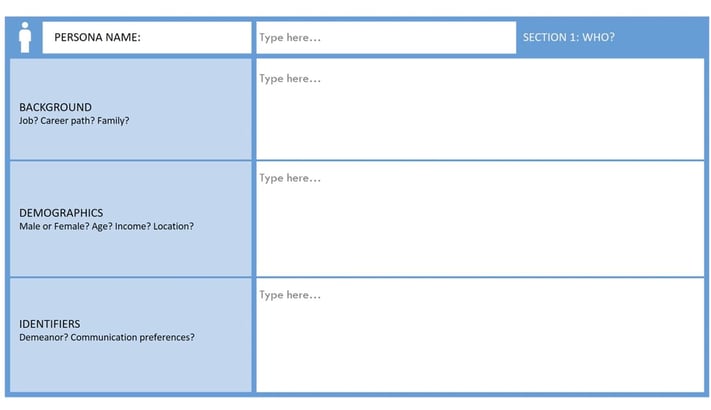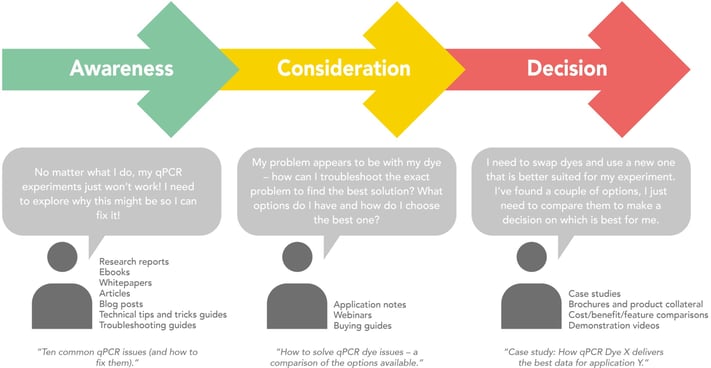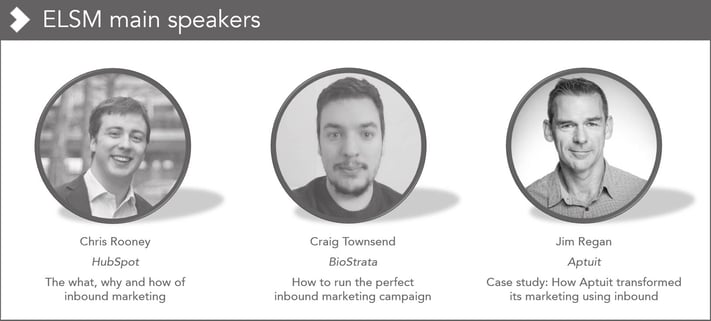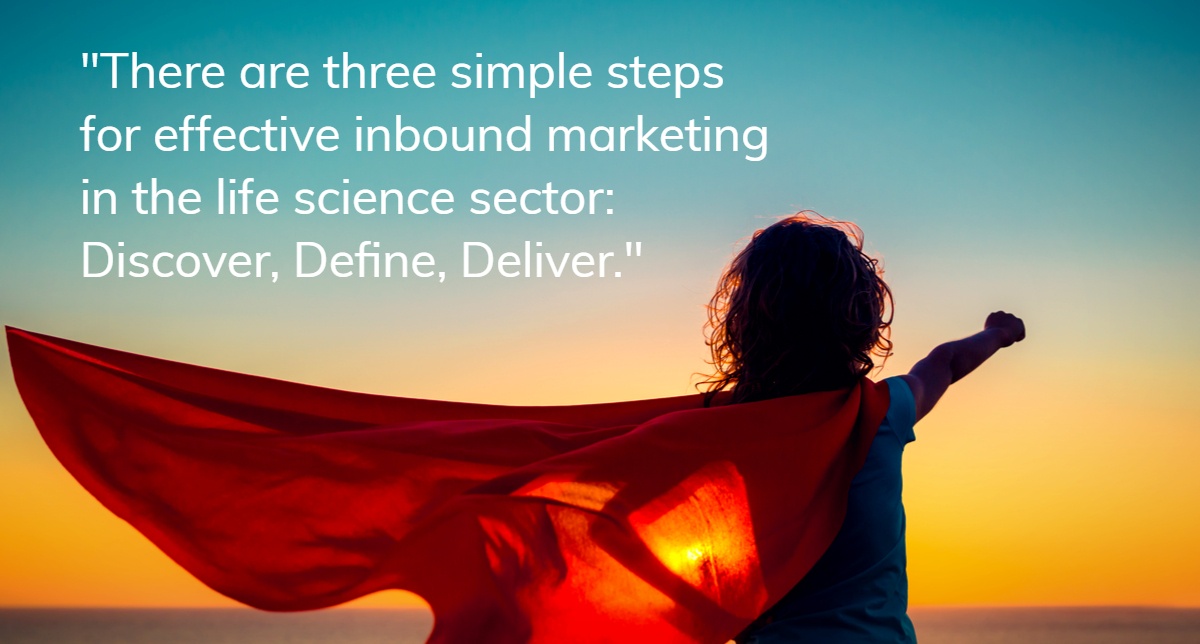At its core, inbound marketing involves producing a steady stream of compelling content that is valuable to potential customers. In return, these customers give companies the chance to interact with them by providing their contact details in order to receive interesting content in the future. This approach can help raise awareness, position your company as a thought leader, create demand, generate leads, and then nurture those leads until they are ready to become customers.
If you have enjoyed some of our previous webinars on why life science marketing needs to change and how inbound marketing can be an effective solution, but aren’t sure how to implement the approach or are looking to enhance your current marketing activities, then look no further. I’m going to show you how to plan and execute the perfect life science inbound marketing campaign today.
In a recent talk at the Evolution of Life Science Marketing (ELSM) event in Cambridge (UK), I went through the three simple steps we take to create successful inbound marketing programmes in the life science sector: Discover, Define and Deliver.
I have summarised these below, but if you’d like to learn more, you can also watch the video of my 40-minute talk, which was recorded as part of the ELSM’s special webinar series.
Step one: Discover
As a first step, you need to know who your best possible customers are, what they are interested in, what their problems and goals are, and what they’re going to be searching for online. Without knowing this, you will find it hard to effectively communicate with them in a way that will cut through the clutter and grab their attention. As such, a crucial exercise is to develop semi-fictional representations of your potential customers, known as 'buyer personas'. Buyer personas define your prospects’ goals, challenges, frustrations, sales objections and common questions, forming a roadmap for creating content for inbound marketing.
Next, it is crucial to understand who you are. For example, why are you unique, and in what ways can you help your buyer personas overcome their problems? For many companies, this type of brand messaging/positioning work will have already been completed. However, it is very important that you phrase your unique selling points, brand values and the unique benefits you offer your customers in language that resonates with their needs. As such, we picture a buyer persona and brand messaging document as two mirrors facing one another—each one should reflect the other. As such, you may need to pass through several iterations, where you work to ensure your brand messaging documents influence your buyer personas and vice versa, until you have your key messages defined in a way that is customer-focussed, rather than too focussed on your company’s own point of view.
Once you have learned who you are targeting and clarified your own positioning, you then need to make sure these are reflected in all of your marketing and sales communications. Inbound marketing will only work when you generate content that will engage buyers, while starting to introduce your unique value proposition (when the time is right, i.e. as they move to the point in the buying journey where they start to research solutions to their problems/opportunities).
Finally, we always recommend performing a content audit, as it helps you get started with inbound quickly and with minimal resource investment. This audit involves analysing your existing content items to ensure that they are aligned with your company’s positioning and unique selling points, framed in a way that will also effectively speak to the interests of your individual buyer personas. Much of your content can probably be easily repurposed to form part of your systemised inbound campaigns, which is why the content audit phase should not be skipped (it will save you time and effort in the long run, we promise!).
Step two: Define
This second step involves taking the strategic framework from the first stage and using it to build a tactical plan for how you will attract your buyer personas. Primarily, this involves stating clearly what you hope to achieve with your inbound marketing programme (e.g. generate new leads, engage existing database, improve conversion rates at a certain stage of your sales process etc.) and building a tactical plan to deliver against those objectives. Most inbound marketing programmes focus on generating new leads, as well as nurturing them over time until they are ready to engage with your team in a sales conversation.
To do this effectively, it is essential to map your existing content to your buyer persona’s journey (i.e. awareness, consideration, decision) and plan new content items to fill in any blanks (this is usually done during the content audit phase). In my ELSM talk, I explained which type of content is best at each buying stage. For example, if lead generation is one of your primary goals, we advise creating high-value content at the awareness stage to promote engagement as early as possible (i.e. before your prospects are even looking for a provider). As Jim Regan from Aptuit reveals in his ELSM talk, Aptuit achieved a huge upsurge in lead generation when they started providing content on their website targeting the awareness stage of the buyer’s journey. However, to successfully nurture these leads through the buying process so they are keen to engage your sales team, you will also need to create consideration- and decision-stage content, which you can use to pull prospects deeper into your sales funnel.

When you know your buyer personas and marketing goals, and have completed your content audit, you can then create a content calendar with blogs, content offers, social media posts, email automation workflows and so on, all with associated publication dates (where applicable). This gives you something to work against as you execute the campaign (often over a 3-, 6- or 12-month period).
Step three: Deliver
Now you have built the perfect life science inond marketing plan, the last step is executing it. We advise using a five-step process: create, publish, promote, monitor, improve. Although I don’t get into the nitty gritty of these steps here, you can get more details by watching the video of my full talk at the ELSM event.
Create
Create effective content by identifying your audience and a subject they care about, which is aligned with your product/service offering. Also, identify which stage of the buyer’s journey you wish to target, and provide content that will be truly valuable to your audience. This usually involves filling gaps in your current content repository (e.g. decision-stage content for buyer persona X, awareness-stage content for buyer persona Y).
Publish
It's crucial to publish your content on your own website, and drive people to it. Your website must be optimized for organic search, simple to navigate, and have great landing pages (detailed tips on designing good landing pages can be found by watching the full version of my talk). Also, we currently advise clients to 'gate' high-value content behind lead capture forms, although you may want to experiment to see which approach best attracts and keeps traffic on your site.
Promote
Without good promotion, how will anyone find you and your content? Use social media, write blogs, send emails to your database, and take your content to events. It is also useful to know what benchmarks you should expect from your promotional activities, such as site visits, average page views for a blog post, email open rates, call-to-action click-through rates etc. These can vary widely, so take a benchmark of your current performance before you start your inbound programme.
Monitor and Improve
It's essential that you monitor your marketing performance to drive success. For example, here at BioStrata we use HubSpot to monitor and optimize our marketing efforts, including their keyword tracker tool, which helps build our SEO and keyword strategies. HubSpot also allows us to see which channels drive the most traffic, leads and customers, so we can do more of what works (and less of what doesn’t). You can also identify underperforming content using this method, such as blog posts and landing pages with low conversion rates, and optimise them to boost results.
Congratulations!
You are now ready to develop and run the perfect inbound marketing campaign. If you would like to learn more, you can access the videos of my full talk as well as the other ELSM presentations from Paul Avery (BioStrata), Chris Rooney (HubSpot) and Jim Regan (Aptuit) below.






